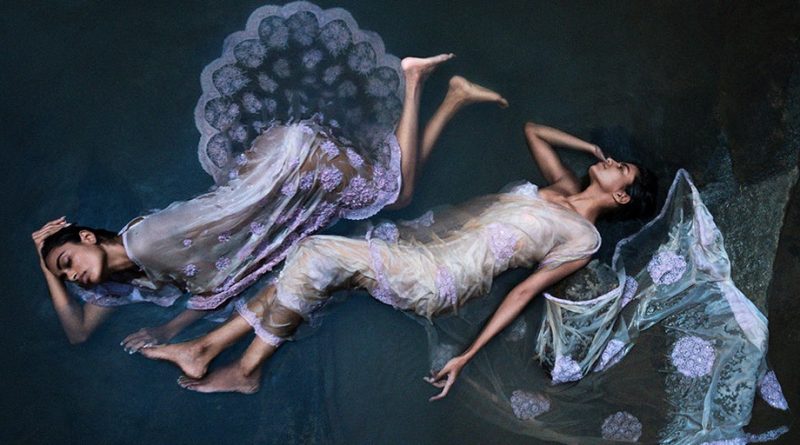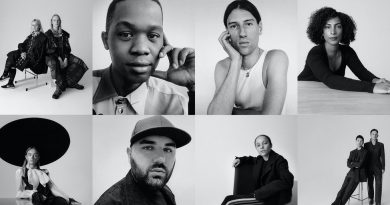India’s Fashion Industry at a Crossroads | Intelligence
MUMBAI, India — “I look at this difficult time as a time for ‘manthan,’ [which in Hindi] means a kind of churning that ultimately leads to clarity,” said Suket Dhir, a designer who will take part in a show tomorrow evening called “All About India” along with five of his peers on the first day of Lakme Fashion Week.
Though many in India’s fashion fraternity are grateful for the outlet, they are quietly concerned that the all-digital format will be replacing what is normally a high-octane event that comes at a pivotal moment in their business calendar. Dhir, by contrast, seems unruffled, almost philosophical, describing the period as “a time for introspection, personal improvement and revaluation.”
India is at a critical juncture in its pandemic crisis and still leads the world in the daily average number of new infections reported, according to a Reuters tracker. A two-month national lockdown earlier this year left millions of workers stranded and the local fashion industry reeling from disrupted supply chains and mounting retail losses. Since then local lockdowns, a faltering economy and strict rules on gatherings for events have presented further challenges.
For Dhir, who won the International Woolmark prize for menswear in 2016 with his alchemical mix of Indian textiles like khadi, cashmere and hand-woven brocades, combined with impeccably relaxed tailoring and subtle details that weave captivating stories through the clothes, this year has been anything but straightforward.
During lockdown, he volunteered for relief work distributing food to migrant labourers while his team, reduced to a skeleton staff, “took care of the little business that came our way.” Since restrictions were lifted, he slowly got production up and running, though it was fraught with challenges. Now, he says with relief, the rural weavers he works with finally have access to government micro-enterprise loans but at one point, some of his suppliers ran out of working capital, and for a while, he had to provide them with assistance.
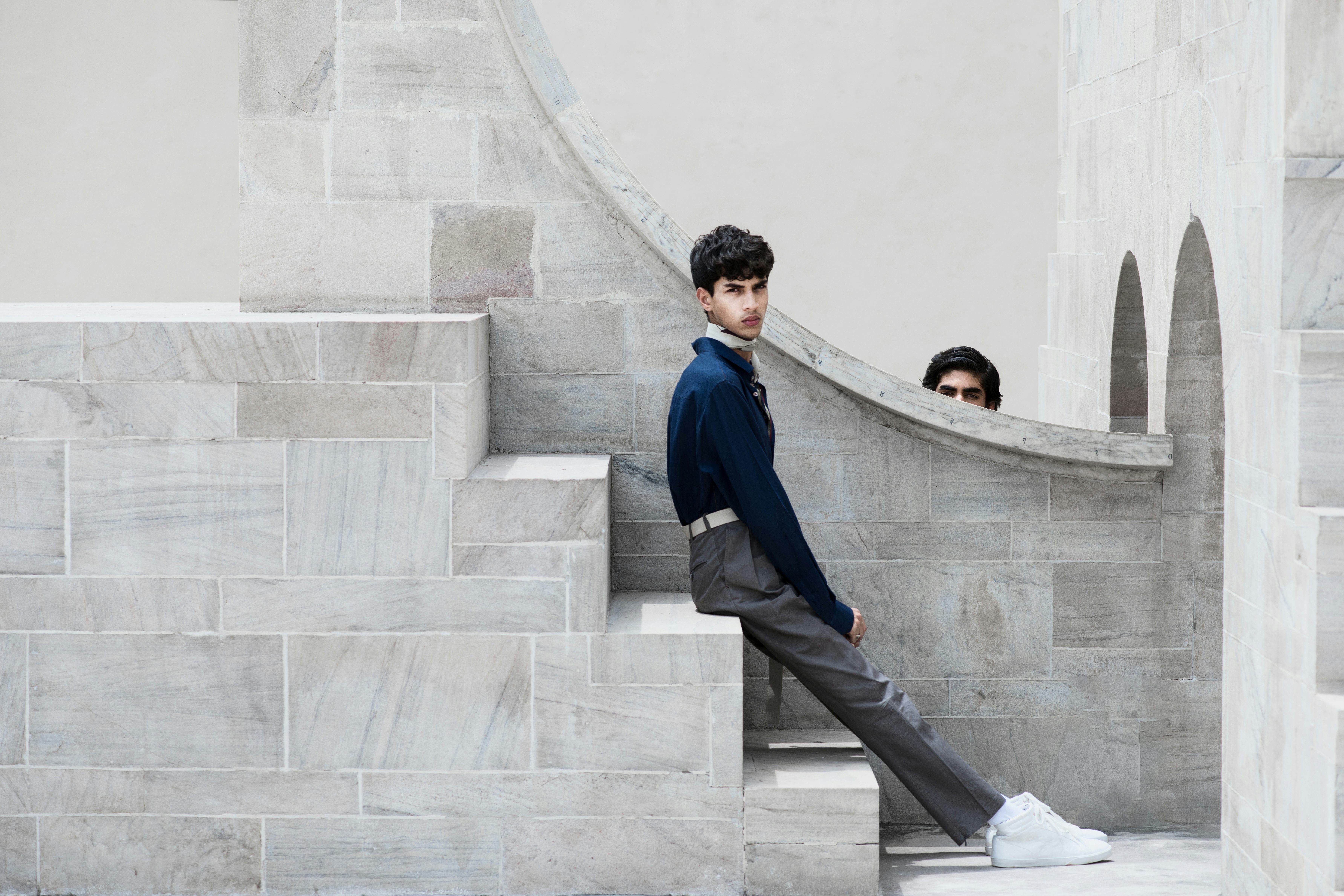
Menswear collection by Suket Dhir; photographed by Pranoy Sarkar | Source: Courtesy
If this were a normal year, countless small, independent designers and brands like Dhir’s — and the tens of thousands of people they employ in production, retail, image creation and back-end operations — would be banking on the business that is generated at India’s two biggest fashion weeks. This year, however, things are of course very different and — although designers around the world share common problems caused by the global crisis — those in India often face starker choices than their peers in Europe or the US.
India Fashion Week, which is presented by the Delhi-based Fashion Design Council of India (FDCI) and sponsored by Lotus Makeup for the past five seasons ran from 14-18 October. The other event, sponsored jointly by Lakme and IMG Reliance, is normally held in Mumbai and will run from 21 to 25 October. Both are taking the form of digital fashion weeks rather than the usual high-energy physical events, begging the question whether they can provide the level of sales needed to tide designer brands over or prevent them from collapsing.
Protecting the craft ecosystem that Indian fashion is built on
If one key learning has come out of the pandemic in India, it’s the ever pressing need to support the artisans who are integral to fashion’s supply chain and its inherent value. During these challenging times, those wise enough to recognise the win-win dynamics of supporting the craft ecosystem as an integral and ongoing part of sustainable business strategies will be more likely to thrive in a post-pandemic world.
Sabyasachi Mukherjee, one of India’s most coveted bridal designers, is emphatic about this. Out of his workforce of 1700 people only 22 percent were able to actually report to work during lockdown, and out of the remaining 78 percent who could not, only 5 percent could continue to work from home.
“Money lost over a season or two can always be recovered eventually but it’s very important to protect the ecosystem that has made us who we are. Every single employee on the payroll has been looked after in the past few months. As an entrepreneur I have taken a bigger overview of this situation,” said Mukherjee.
Both Sabyasachi as well as designers like Rahul Mishra showed as part of the Fashion Design Council of India (FDCI’s) India Couture Week (ICW), which this season took place from 18 to 23 September in its first ever all-digital format.
Mishra’s collection called “Lotus Pond” harnessed the digital format to focus up-close on the exceptional embroidery work of the artisans and asked viewers to ponder ‘what is the relevance of couture in such times?’ For Mishra, the beauty of couture is deeply connected to the livelihoods of the highly skilled embroidery artisans he works with.
The draw of craft in turbulent times is also evident in brands like Nappa Dori, whose stores in Delhi, Mumbai and London sell finely crafted leather bags, satchels and accessories made by artisans in North Delhi. With a huge drop in footfall due to the loss in both international and domestic tourism, brand founder Gautam Sinha was forced to permanently close two of his five Delhi-based stores. However, with an already well-established e-commerce channel, he is seeing some bright spots.
“We saw a two-to-three hundred percent spike in sales of candles, lacquered trays, desk accessories and bar tools,” he said. As a result, the brand will soon launch a separate line called “Dori Living,” which will focus on homewares. It is a pivot, Sinha says, that was long in planning but fast-tracked as a result of the events of 2020.
Opening direct channels and relying more on the attention economy
Like designers everywhere, those in Delhi and Mumbai have been investing more in e-commerce to try to open up or expand their direct-to-consumer (DTC) channels.
But Sinha notes that no matter how beautifully made an e-commerce site is, advertising remains key to drive traffic to it. For many small designers, he suggests, the associated advertising costs are simply too expensive. This lends weight to the argument for a well-timed and well-executed fashion show. In the real world and in a normal year, the media value of a successful show can pay dividends for smaller brands. This season, however, designers are not only worried about how to stand out against their peers but also how to stand out in a digital format which may not generate the same buzz.
Given the upcoming festival season of Diwali which will fall in mid-November, designers will no doubt be hoping the new virtual B2C showrooms and see-now-buy now facilities provided by both Lakme and Lotus to create direct engagement with the end customer will bring much needed business at the close of a turbulent year.
This switch to digital also needs to sufficiently draw wholesale buyers, especially since some Indian designer brands from the fashion weeks that have already taken place this month are reporting a staggering drop in sales — some by as much as two-thirds of sales wiped off their pre-Covid levels.
A focus on converting attention to sales is a key focus for organisers at Lakme Fashion Week this season, meaning a significant pivot for the event as a whole from B2B to B2C.
We feel that designers are looking for better working capital efficiency and hence direct-to-consumer sales will also be a focus this season.
“We feel that designers are looking for better working capital efficiency and hence direct-to-consumer sales will also be a focus this season,” said Jaspreet Chandok, head of lifestyle businesses, IMG Reliance said. “Lakme has ramped up its technology to facilitate a ‘see it now buy it now’ model for B2C.”
Ashwath Swaminathan, Head of Innovations at Lakme, added that “some of our new interventions are the virtual showroom that will facilitate B2B transactions and the hub where all the content will reside. The hub will provide a new digital experience for audiences to ‘shop off the runway’ and even choose camera angles to augment the viewing experience.”
Enabling designers to participate in digital fashion weeks, where resources may be low and where this season’s sales could mean the difference between surviving or not, is a key focus for the FDCI. This season organisers offered designers all the facilities to shoot a digital film at substantially reduced costs as part of the Lotus-sponsored India Fashion Week usually held in Delhi. FDCI chairman Sunil Sethi said, “It’s our way of nurturing talent and creativity during this difficult time.”
Given that many designers in India have large NRI audiences (non-resident Indians and people of Indian origin living abroad) who are currently unable to travel to India, digital shows can help keep them connected with an important customer base.
Vaishali Shahdasgupta, whose designs cross over from bridal to special occasion wear, showed on the second day of Lotus-sponsored India Fashion Week. “The digital show and virtual store are a great support to keep in touch with my NRI clients,” she said. “It’s not the same depth of engagement but it’s good preparation work for the months ahead when finally we will be able to have face-to-face meetings.”
The bridal sector is comparatively robust but could change
Nowhere does aspiration and fantasy manifest more than in India’s vast and lucrative bridal wear market. However, at a time when strict government rules on gatherings are in force (currently no more than 100 guests are allowed), designers in this once-considered recession-proof market are also feeling trepidation.
“It will get worse before it gets better; the country will go into a deep recession” predicted Tarun Tahiliani, one of India’s most renowned designers who showcased an exquisitely embroidered collection in subdued hues of pale jade and tea rose at the Lotus-sponsored event.
Earlier this month, the Reserve Bank of India said that GDP would contract by 9.5 percent during the current April to March financial year. Days later the government announced that it would inject a $10 billion stimulus package into the economy, though at least one prominent economist responded unfavourably to the response characterising it as “underwhelming.” In the country’s worst-hit quarter of 2020, ending June, the economy contracted by 23.9 percent year-on-year.
There are those who believe that, even after restrictions are eventually lifted, some Indians may choose to have smaller weddings in the future. Perhaps surprisingly, some bridal designers say this would signal a welcome change.
“Whereas usually the focus is on making a big impact to a guest list of five-hundred or more, “lockdown weddings” entail a greater focus on craft and detail, elements that a small group of guests will see up close and also good for Instagram,” said Delhi-based designer Gaurav Gupta
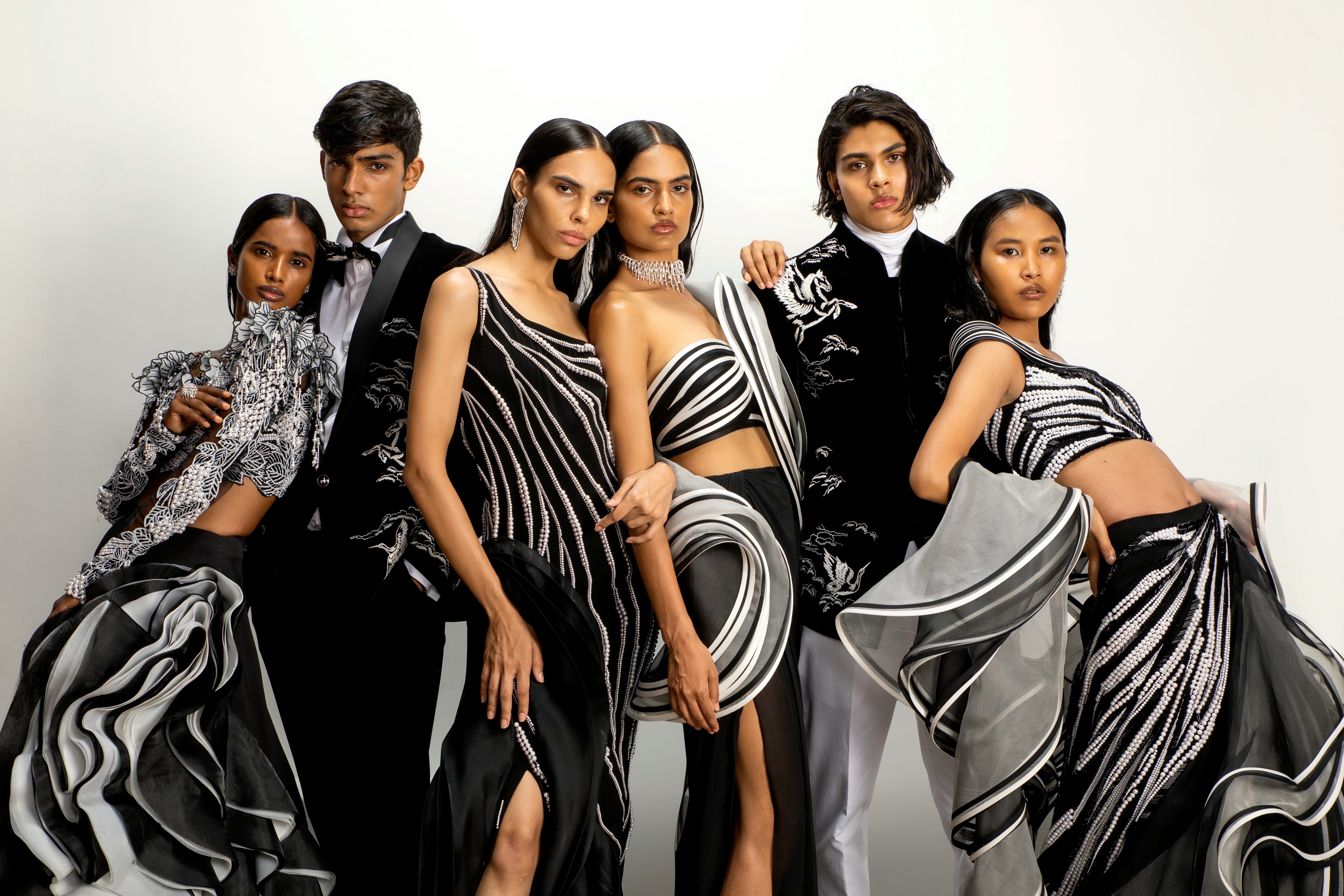
From “My Name is Love” Couture 2020 by Gaurav Gupta | Photo: Studio Thirty6
As part of the September India Couture Week, Gupta presented a short film called “My Name is Love.” A sonorous reading by poetess Navkirat Sodhi and original piano score by Sahil Vasudeva anchored the show, which featured India’s first openly transgender model Anjali Lama, non-binary individuals and same sex couples all modelling Gupta’s sculptural creations
Other industry insiders agree that the “big fat Indian wedding” and its obsessions with fanciful concoctions of a feudal royal heritage and heavy, blinged-out lehengas has gotten out of hand. For now at least, the pandemic seems to have heralded a welcome pause, though others doubt it will cause a permanent reset on the culture of decadent nuptials.
Some designers are finding new opportunities in the subdued bridal market. “As a label we haven’t tapped into hard-core bridal wear but our main effort has been to cater to the family and friends of the bride and groom,” said Karan Torani, of his eponymous two-year old label Torani, who has rapidly gained attention for the heritage artisanal aesthetic drawing on his Sindhi roots.
“In a certain way, the pandemic has in fact opened up our market. Clients are now looking for designer outfits that have a repeat value and speak of a certain quiet luxury,” he said.
Yet the brand’s newly opened store in Delhi’s Khan Market has been hit hard, with retail sales down to thirty percent of that in 2019. Torani won’t show this season, instead focusing on his track-record of producing viral social media campaigns through stunning imagery.
Navigating through a tough period for the wider Indian luxury market
Most Indian designers showing at this month’s two fashion weeks share a customer base with international luxury brands, and are often situated in malls like Delhi’s DLF Emporio, The Chanakya or Mumbai’s Palladium typically with a mix of luxury brands on the ground floor and Indian designer stores on the upper tiers.
Early anecdotal evidence suggests that India’s $30 billion luxury market was hit hard during the pandemic and it remains unclear when the sector will make a full recovery. Whilst occasion-based bridal wear will continue to be commercially dominant and will likely be somewhat resilient long-term, day wear from international luxury brands and Indian designer wear could be less resilient.
Like other upmarket retailers, Le Mill, a go-to destination for Mumbai’s elite selling both international and Indian designers, saw footfall drop by 60 to 70 percent during the height of the crisis, and prompted the boutique’s co-founder Cecilia Morelli Parikh to pivot more quickly than planned to e-commerce. The boutique stocks Saint Laurent, Chloé, Balmain and Zimmerman among others.
Morelli Parikh predicts that more luxury shopping in India will move online but adds “a lot of the large purchases only happen once a live conversation happens between seller and customer. Seeing the piece live in the store via FaceTime or WhatsApp helps convert the sale. We’re really living the omnichannel argument [now].”
Going forward, her goal is “to increase the sales that come from domestic vendors to 30 percent from only 10 percent today. It’s a commitment to the local designers and artisans we’re very keen to keep,” she said.
“We have been selling a lot of easy pieces, not exactly loungewear, but loose dresses for example, or wide-legged pants. We have also sold a lot of bags. Investment pieces that make the client feel good, without needing an occasion to justify the purchase. This is quite the opposite to consumer behaviour prior to Covid.”
People are either buying things that are well-priced and easy to wear or special things for specific occasions.
At multi-brand designer boutique chain Ogaan, which sells Indian designer brands such as Bodice, Pero, Rajesh Pratap Singh and Eka, buying patterns are slightly different. “People are either buying things that are well-priced and easy to wear or special things for specific occasions,” said Managing Director Aashti Bhartia.
Similarly, Darshan Mehta, president and chief executive of Reliance Brands Limited (RBL) reports a distinct pattern of comfort and utility, alongside purchases of bags and special pieces of jewellery such as “promise rings” for couples whose weddings had to be postponed.
“There is a clear shift towards comfort wear, whether it be sneakers and slip-on footwear, polos and casual linen-wear or tracks and loungewear,” he said, pointing to brands like Zegna, Bottega Veneta, Canali and Tiffany as the group’s strongest luxury performers this year.
Seeking connectedness and clarity in a time of churn
Unsurprisingly, some Indian designers are inherently better placed than others to deliver on consumers’ new priorities.
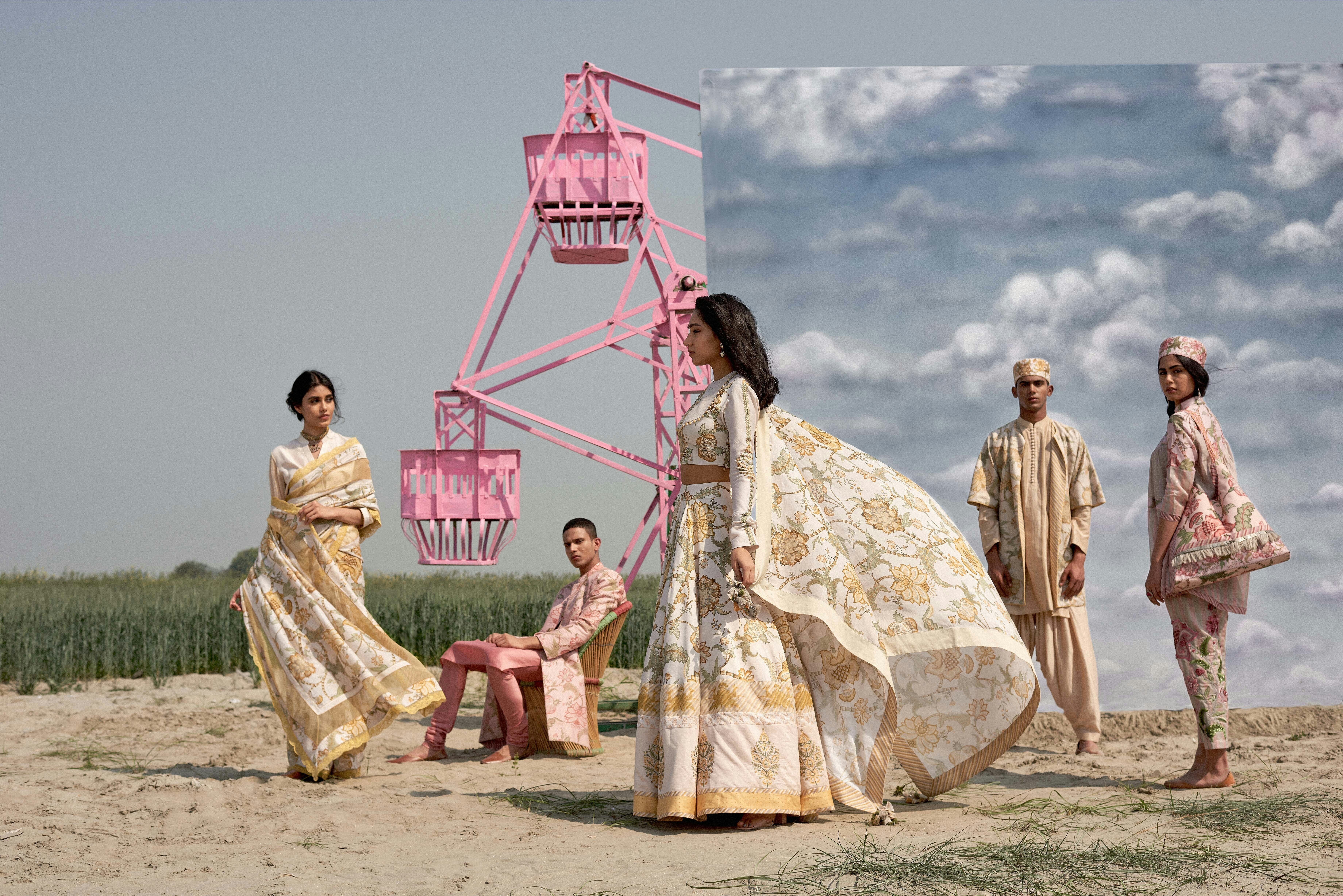
From “Gulab Mehla” Spring/Summer 2020 collection by Karan Torani; photographed by Pranoy Sarkar | Source: Courtesy
Shani Himanshu and Mia Morikawa, the duo who founded the brand 11.11/eleven eleven in 2010, are well respected for how they approach the intersection of fashion, sustainability and craft.
Morikawa speaks of handloom’s “soothing quality” and how it invokes a sense of “connectedness and wellbeing.” It speaks to a hankering for the human touch with an enormous legacy of nostalgia for Gandhian values surrounding hand craft in India, as well as resonance in markets where fast fashion’s impacts have been increasingly under the microscope.
The duo have not so much pivoted to the ongoing challenges but recognised that in the pause and sense of “pressing reset” it has created, is an opportunity to push forward the vision of a brand whose time may have truly come.
“We are currently working directly with around 360 artisans who are located in New Delhi, Kutch, West Bengal, and Andhra Pradesh. The lockdown brought the entire system to a standstill,” said Morikawa. “To keep the consistency and system running after the lockdown required the infusion of funds for raw materials and to support the artisans’ daily household needs.”
Morikawa notes that before the pandemic, most of their business was happening though stores, and 40 percent of the audience were tourists. Now, most of their retail is online or through WhatsApp, with domestic Indian retail sales reduced dramatically down by as much as 80 percent. Some relief has come through their international expansion, though.
“Our online business has grown outside India, due to a PR push in relation to our launch on Mr. Porter, Matches and the Stoffa collaboration. This increase in visibility to a global audience is the positive side of our retail journey [during the pandemic].”
Dhir believes that, although next year will be very tough for the Indian market, there are silver linings to the crisis. “What I usually do with our clients and consumers in person cannot be achieved anymore with these restrictions in movement and meeting [but] that gives my team and I a lot of time to communicate through social media and the digital fashion week platform.”
Perhaps most importantly, the churn of 2020 has brought him a new sense of clarity — both in terms of his creative mission and his priorities as an entrepreneur. “The design work we’ve done this time is my best work so far [so now I can go with confidence to] visit my weavers at the end of October for the new sampling.”
Related Articles:
Luxury Brands Have a ‘Respect Deficit’ with Indian Artisans
How Fashion Perpetuates Modern-Day Colonialism

